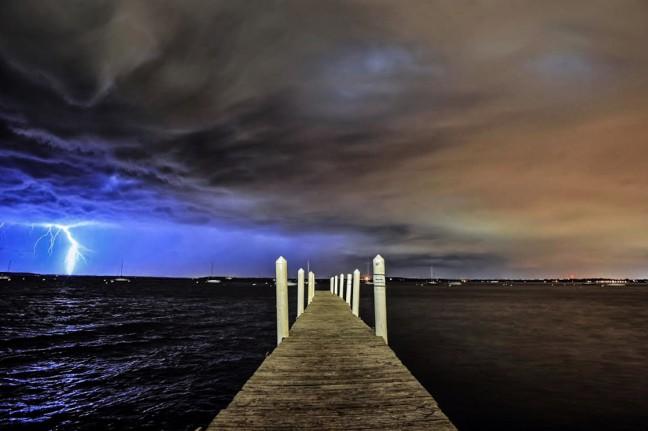Surrounded by water, University of Wisconsin students swim, kayak, canoe and sail as part of their culture.
The added recreation, however, can sometimes come with added dangers.
Lake Mendota’s most recent tragedy occurred last June when 22-year-old Edgewood College student Mohammad “Hamood” Bagabir’s body was found three-fourths of a mile from Memorial Union in approximately 60 feet of water.
While incidences such as this cause panic and are often reported, Sean Geib, assistant supervisor for UW Lifesaving Station, said the work provides a unique vigilance on Lake Mendota that helps prevent tragedies.
UW “lifesavers”
On the eastern side of the isthmus near James Madison Park, the station keeps watch on the lake from a tower that was built after UW President Charles Van Hise ordered it in response to the drowning of two UW students in 1908. Station staff are called “lifesavers.”

Geib said the lifesavers’ primary job is to keep an eye on the lake. UW Lifesaving Station provides assistance to UW-affiliated lake users and private lake users if needed. With two 30-foot rescue boats and four staff on the job, the lifesaving crew keeps their binoculars on the water and attention on the phones in case of emergency calls seven days a week through sunset.
“The crazy thing about our job — there aren’t any other places like us,” Geib said. “A lake of this size in a city where you have an undergrad population of over 40,000, we’re really in a unique situation here to provide this type of service.”
Out on the tower, lifesavers watch approximately 80 percent of the lake, with the exception of some blind spots. For the Langdon Street shoreline, the tower has set up a camera on the sail tower behind Helen C. White.
UW has the second largest sailing club in the country and the UW Lifesaving Station has a distinct presence in maintaining safety on Mendota, Geib said. The organization also works closely with Madison Police Department and Dane County Sheriff’s Office to respond as quickly as possible to emergency situations.

Earlier this month, Head of Instruction for Hoofer Sailing Club David Elsmo, said an intoxicated person at Picnic Point went into the water to go to the bathroom and starting drowning before being resuscitated and rescued. Geib said an incident like this might not be reported, but is managed and recorded within the UW Lifesaving Station.
Geib recalled a sunny 80-degree day in April when the water was 50 degrees and three students went overboard without life jackets from their canoe. With beer and a camera on board, the students joked to the lifesavers about how cold it was when they had been waiting a mile out from shore.
“That never made the paper, but we go home like, we just saved three lives,” Geib said. “The crazy thing is they didn’t realize that.”
Safety and prevention
Both Hoofers and UW Lifesavers work together to not only respond to dangers on the lake, but to prevent accidents from occurring.
Elsmo said there was a period of four years in which there were no drownings, and suddenly three within a three-month period. Because of the contributing factor of alcohol, Hoofers has since adapted a strict zero-tolerance policy for alcohol on any of its outdoor recreational programs.
“Alcohol doesn’t make anybody a better swimmer,” he said.
Wisconsin Department of Natural Resources regulations for being out on water are much looser, Elsmo said.
Kyle Drake, recreational safety warden for Wisconsin DNR, said legislation is pending to require anyone on a boat to wear a life jacket at all times.
“[I’m] not sure why it’s not getting the support it needs,” Drake said. “So far there is federal regulations that anyone under 13 has to wear a life jacket at all times, but Wisconsin has not adopted that yet.”
As an educational sailing institution, Hoofers enforces higher restrictions for going sailing, Elsmo said.
Mary Kay Dadisman, assistant director for external relations at Wisconsin Union, said since the most recent incident, everybody on a boat is required to wear a life jacket. Previously, a swimming test could be taken to determine whether an individual could have permission to have the life jacket present, but not on.
Elsmo said when anything severe occurs, Hoofers has a meeting with UW Lifesaving Station, and other groups who are involved with safety and prevention on the water, to assess the situation and discuss any changes that need to be made.

Hoofers enforces a man-overboard drill, Dadisman said, where a float is thrown out of the sailboat in various types of conditions and another sailor must go back and retrieve it.
“This man-overboard training happened before the most recent drowning that we had,” Elsmo said. “Anytime you are not on a boat, you’re not in the safest scenario. If you’re a sailor you’re not a swimmer.”
Elsmo said the university’s presence allows students from different areas to experience living near water for the first time. That can also present some challenges, however, when students are unaware of the dangers.
While the lake doesn’t pose the same dangers rivers might have, like currents, there are still many precautions that need to be taken, Elsmo said.
“I grew up around water and I look at it as a very benign thing, but there are some people who look at it and have no idea,” Elsmo said.
Correction: A previous version stated that the man overboard training involved a person going into the water. The actual training uses a float so that no individual is in the water unless there is a real emergency.
Also, a previous statement said the previous lifejacket policy allowed for anyone to be on a boat without wearing the lifejackets, whereas the policy actually involved a swim test to grant that permission.




















